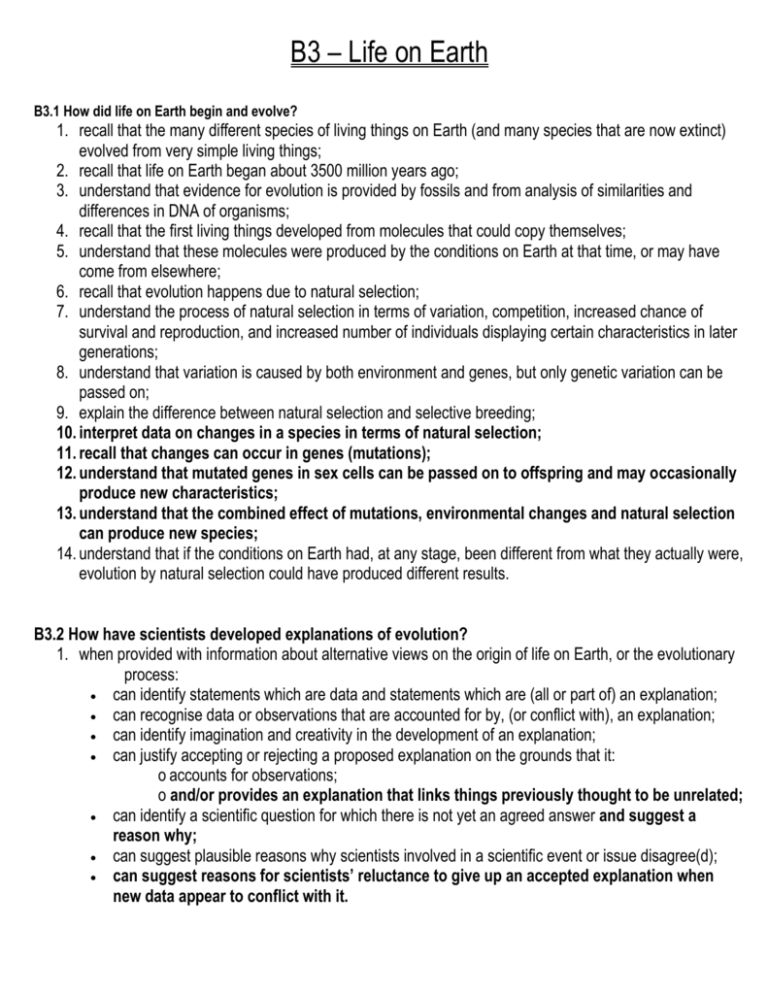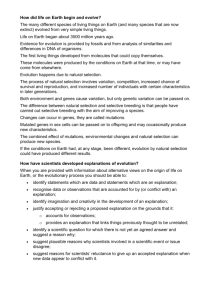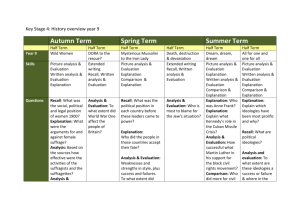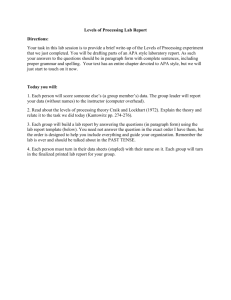extinct cells
advertisement

B3 – Life on Earth B3.1 How did life on Earth begin and evolve? 1. recall that the many different species of living things on Earth (and many species that are now extinct) evolved from very simple living things; 2. recall that life on Earth began about 3500 million years ago; 3. understand that evidence for evolution is provided by fossils and from analysis of similarities and differences in DNA of organisms; 4. recall that the first living things developed from molecules that could copy themselves; 5. understand that these molecules were produced by the conditions on Earth at that time, or may have come from elsewhere; 6. recall that evolution happens due to natural selection; 7. understand the process of natural selection in terms of variation, competition, increased chance of survival and reproduction, and increased number of individuals displaying certain characteristics in later generations; 8. understand that variation is caused by both environment and genes, but only genetic variation can be passed on; 9. explain the difference between natural selection and selective breeding; 10. interpret data on changes in a species in terms of natural selection; 11. recall that changes can occur in genes (mutations); 12. understand that mutated genes in sex cells can be passed on to offspring and may occasionally produce new characteristics; 13. understand that the combined effect of mutations, environmental changes and natural selection can produce new species; 14. understand that if the conditions on Earth had, at any stage, been different from what they actually were, evolution by natural selection could have produced different results. B3.2 How have scientists developed explanations of evolution? 1. when provided with information about alternative views on the origin of life on Earth, or the evolutionary process: can identify statements which are data and statements which are (all or part of) an explanation; can recognise data or observations that are accounted for by, (or conflict with), an explanation; can identify imagination and creativity in the development of an explanation; can justify accepting or rejecting a proposed explanation on the grounds that it: o accounts for observations; o and/or provides an explanation that links things previously thought to be unrelated; can identify a scientific question for which there is not yet an agreed answer and suggest a reason why; can suggest plausible reasons why scientists involved in a scientific event or issue disagree(d); can suggest reasons for scientists’ reluctance to give up an accepted explanation when new data appear to conflict with it. B3.3 How did humans evolve? How are our nervous systems organised? 1. recall that the evolution of multicellular organisms has led to nervous and hormonal communication systems; 2. recall that sensor (receptor) cells detect stimuli and effector cells produce responses to stimuli; 3. recall that nervous systems are made up of nerve cells (neurons) linking receptor cells (e.g. in eyes, ears and skin) to effector cells (in muscles/glands); 4. recall that in humans and other vertebrates the nervous system is coordinated by a central nervous system (spinal cord and brain); 5. understand that nervous systems use electrical impulses for fast, shortlived responses; 6. recall that hormones are chemicals which travel in the blood and bring about slower, longer-lasting responses; 7. recall two examples, in humans, of each of nervous and hormonal communication; 8. recall that nervous and hormonal communication systems are involved in maintaining a constant internal environment (homeostasis); 9. recall that the evolution of a larger brain gave some early humans a better chance of survival; 10. understand human evolution in terms of a common ancestor, divergence of hominid species, extinction of all but one of these species. 11. when provided with additional information about human evolution: can draw valid conclusions about the implications of given data for a given theory, for example: recognises that an observation that agrees with a prediction (derived from an explanation) increases confidence in the explanation but does not prove it is correct; recognises that an observation that disagrees with a prediction (derived from an explanation) indicates that either the observation or the prediction is wrong, and that this may decrease our confidence in the explanation. B3.4 Why do some species become extinct, and does it matter? What is the importance of biodiversity? 1. understand that living organisms are dependent on the environment and other species for their survival; 2. understand that there is competition for resources between different species of animals or plants in the same habitat; 3. relate changes affecting one species in a food web to the impact on other species that are part of the same food web; 4. understand that a rapid change in the environment may cause a species to become extinct, for example, if: the environmental conditions change; a new species that is a competitor, predator or disease organism of that species is introduced; another organism in its food web becomes extinct; 5. understand that species have become extinct (or are in danger of becoming extinct) and that this is likely to be due to human activity; 6. recall two examples of modern extinctions caused by direct human activity, and two caused by indirect human activity; 7. explain why maintaining biodiversity is an important part of using the environment in a sustainable way; 8. understand that biodiversity may be important for the future development of food crops and medicines.








